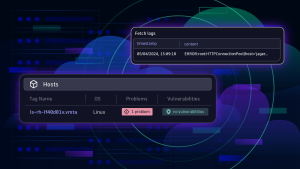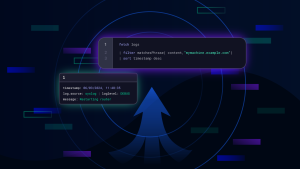As organizations shift away from the traditional IT model, many look to go serverless. Find out how to maximize serverless benefits and avoid the disadvantages of serverless computing.
Many organizations today rely on cloud-native applications for their scalability and agility, among other benefits. However, not all cloud strategies are the same. Some organizations prefer a serverless approach. Serverless computing provides on-demand access to back-end services on a per-use basis. While serverless benefits have driven substantial market growth over the past few years, there are also disadvantages to serverless computing.
Before deciding whether serverless computing is right for your organization, it’s important to understand how the as-a-service model works, how to balance serverless benefits and challenges, and how intelligent observability can help.
What is serverless computing, and how does it work?
Despite the name, serverless computing still uses servers. Unlike a traditional IT model, however, cloud providers own and manage these resources.
The providers then deliver compute resources on a per-use basis. This means companies can access the exact resources they need whenever they need them, rather than paying for server space and computing power they only need occasionally. Popular examples include AWS Lambda and Microsoft Azure Functions, but new providers are constantly emerging as this model becomes more mainstream.
Finally, because the delivery of compute resources happens entirely in the cloud, the technology enables enterprises to go serverless at the local level.
Understanding serverless benefits and how to maximize them
Serverless benefits include the following:
- Dynamic scalability. Serverless computing’s cloud-based approach means organizations can scale compute up or down on demand. This lowers the risk of over- or under-provisioning.
- Cost-effectiveness. Better cost control is a key feature of serverless computing. Rather than spending more on resources just in case, organizations can access what they need at any time and only pay for what they use.
- Increased agility. If servers reach maximum load and capacity in-house, something has to give before adding new services. In a serverless model, agility comes standard with anytime access to more resources.
- Faster time to market. Code development also benefits from a serverless approach. Application developers can spin up isolated test environments that pose no risk to current operations. Then, they can apply DevSecOps best practices to fully test new code and see what breaks without affecting current operations.
- Reduced latency. Serverless architecture makes it possible to host code anywhere, rather than relying on an origin server. By using cloud providers with multiple server sites, organizations can reduce function latency for end users.
- Optimizes resources. Serverless computing frameworks typically rely on software containers to provide on-demand performance and provisioning. This approach also enables developers to make optimal use of containerized microservices that they can incorporate into multiple applications, taming software complexity.
- No infrastructure to maintain. Because cloud providers own and manage back-end infrastructure, local IT teams aren’t responsible for ongoing maintenance and upgrades.
What are the disadvantages of serverless computing?
Though serverless computing comes with a host of benefits, it also has its challenges. The disadvantages of serverless computing include the following:
- Loss of control. Because cloud providers own and operate servers in the serverless model, IT teams relinquish some control.
- Lack of skills and resources. Effectively managing serverless environments requires a different skill set than on-premises server support. As a result, teams may find themselves struggling to keep pace with resource requests.
- Security concerns. Using off-site servers to deliver back-end infrastructure introduces security concerns. If the cloud provider suffers a breach or if something interrupts the connection between the provider and the enterprise, the results could be disastrous.
- Architectural complexity. Serverless solutions introduce a new level of complexity into IT environments by adding another infrastructure layer that requires continual monitoring to ensure efficacy.
- Third-party dependency. Shifting to a serverless model increases third-party dependency. This aspect could create operational challenges if third parties lack robust security or are taken offline due to natural disasters or large-scale networking attacks.
- Difficult to test. Testing infrastructure on site is often time-consuming but relatively straightforward. Serverless architecture, meanwhile, requires continual communication with cloud providers to ensure regular testing.
- Difficult to monitor. Monitoring is often cited as one of the biggest challenges to serverless computing. While IT teams have complete access to on-site server connections and interdependencies, serverless architecture is several layers removed from local operations, reducing total visibility.
How intelligent observability can help organizations find balance
While it’s impossible to eliminate all of the challenges of serverless computing, organizations can find balance with intelligent observability. In practice, this means deploying tools capable of keeping pace with the evolving nature of serverless solutions to provide accurate, on-demand insight about what’s happening, when, and why. Dynatrace PurePath provides end-to-end, automatic, code-level visibility, while the Dynatrace Davis AI engine can use this data to pinpoint the root causes of serverless computing challenges. Davis also provides automatic alerts of service-to-service communication issues to drive immediate, effective action.
Serverless computing offers the benefits of on-demand access to back-end resources for code development and execution, but it also comes with challenges around complexity and control. To make the most of serverless solutions, enterprises need AI-driven observability capable of proactively pinpointing potential problems, identifying root causes, and suggesting effective action.
Want to learn more? Check out our newest Power Demo: Taking Serverless Functions to the Next Level with Automatic and Intelligent Observability.





Looking for answers?
Start a new discussion or ask for help in our Q&A forum.
Go to forum